Please see the updated captive-bred marine fish species list for 2023!
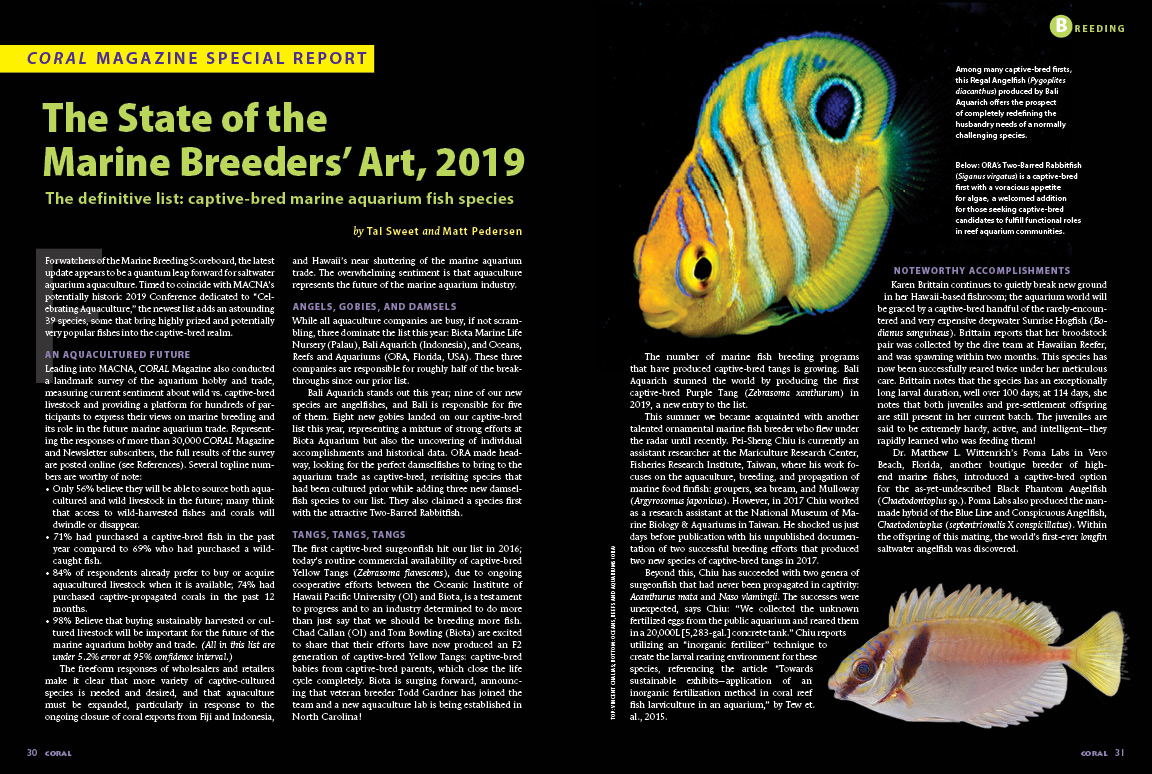
The CORAL Magazine & Marine Breeding Initiative recap of captive-breeding breakthroughs has been published in the September/October 2019 issue of CORAL Magazine.
A CORAL SPECIAL REPORT: The State of the Marine Breeder’s Art, 2019
by Tal Sweet and Matt Pedersen
CORAL Magazine’s Annual Listing of captive-bred marine aquarium fish species, current through early August, 2019
Excerpt from the September/October 2019 issue of CORAL Magazine – subscribe today!
For watchers of the Marine Breeding Scoreboard, the latest update appears to be a quantum leap forward for saltwater aquarium aquaculture. Timed to coincide with MACNA’s potentially historic 2019 Conference dedicated to “Celebrating Aquaculture,” the newest list adds an astounding 39 species, some that bring highly prized and potentially very popular fishes into the captive-bred realm.
An Aquacultured Future
Leading into MACNA, CORAL Magazine also conducted a landmark survey of the aquarium hobby and trade, measuring current sentiment about wild vs. captive-bred livestock and providing a platform for hundreds of participants to express their views on marine breeding and its role in the future marine aquarium trade. Representing the responses of more than 30,000 CORAL Magazine and Newsletter subscribers, the full results of the survey are posted online (see References). Several topline numbers are worthy of note:
- Only 56% believe they will be able to source both aquacultured and wild livestock in the future; many think that access to wild-harvested fishes and corals will dwindle or disappear.
- 71% had purchased a captive-bred fish in the past year compared to 69% who had purchased a wild-caught fish.
- 84% of respondents already prefer to buy or acquire aquacultured livestock when it is available; 74% had purchased captive-propagated corals in the past 12 months.
- 98% believe that buying sustainably harvested or cultured livestock will be important for the future of the marine aquarium hobby and trade.
(All in this list are under 5.2% error at 95% confidence interval.)
The free-form responses of wholesalers and retailers make it clear that more variety of captive-cultured species is needed and desired, and that aquaculture must be expanded, particularly in response to the ongoing closure of coral exports from Fiji and Indonesia, and Hawaii’s near shuttering of the marine aquarium trade. The overwhelming sentiment is that aquaculture represents the future of the marine aquarium industry.
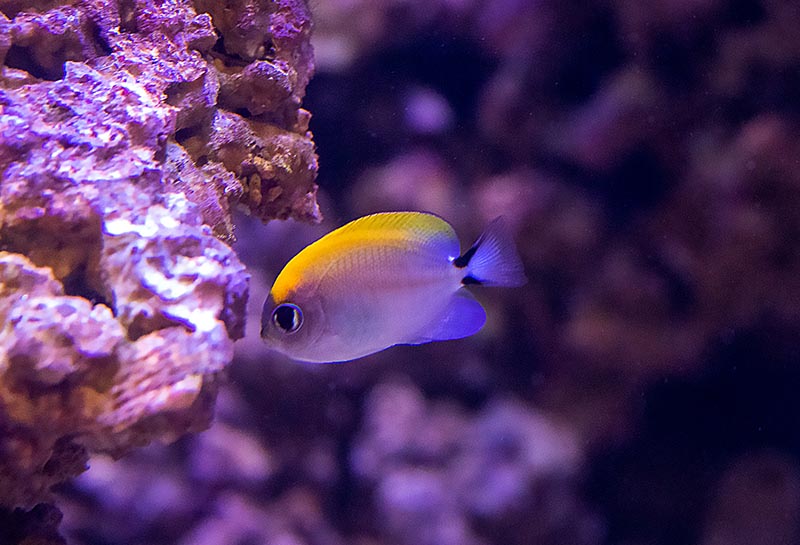
Among many other accomplishments, Biota introduced a surprise success, captive-bred Spotbreast or Swallowtail Angelfish, Genicanthus melanospilus. Image Credit: Jake Philipps/Biota Aquariums
The Industry Gives Us Angels, Gobies, and Damsels
While all aquaculture companies are busy, if not scrambling, three dominate the list this year: Biota Marine Life Nursery (Palau), Bali Aquarich (Indonesia), and Oceans, Reefs and Aquariums (ORA, Florida, USA). These three companies are responsible for roughly half of the breakthroughs since our prior list.
Bali Aquarich stands out this year; nine of our new species are angelfishes, and Bali is responsible for five of them. Eight new gobies landed on our captive-bred list this year, representing a mixture of strong efforts at Biota Aquarium but also the uncovering of individual accomplishments and historical data. ORA made headway, looking for the perfect damselfishes to bring to the aquarium trade as captive-bred, revisiting species that had been previously cultured, while adding three new damselfish species to our list. They also claimed a species first with the attractive Two-Barred Rabbitfish.
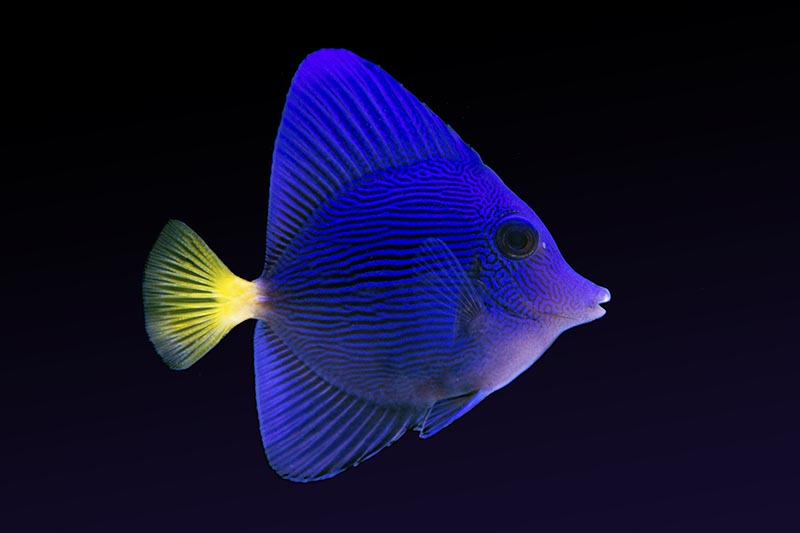
The world’s first captive-bred Purple Tang (Zebrasoma xanthurum) was produced by Bali Aquarich, entered the
aquarium trade through Quality Marine, and was retailed through the LiveAquaria® Diver’s Den® WYSIWYG Store. Image credit: Quality Marine
Tangs, Tangs, Tangs
The first captive-bred surgeonfish hit our list in 2016; today’s routine commercial availability of captive-bred Yellow Tangs (Zebrasoma flavescens), due to ongoing cooperative efforts between the Oceanic Institute of Hawaii Pacific University (OI) and Biota, is a testament to progress and to an industry determined to do more than just say that we should be breeding more fish. Chad Callan (OI) and Tom Bowling (Biota) are excited to share that their efforts have now produced an F2 generation of captive-bred Yellow Tangs: captive-bred babies from captive-bred parents, which close the life cycle completely. Biota is surging forward, announcing that veteran breeder Todd Gardner has joined the team and a new aquaculture lab is being established in North Carolina!
The number of marine fish breeding programs that have produced captive-bred tangs is growing. Bali Aquarich stunned the world by producing the first captive-bred Purple Tang (Zebrasoma xanthurum) in 2019, a new entry to the list.
This summer we became acquainted with another talented ornamental marine fish breeder who flew under the radar until recently. Pei-Sheng Chiu is currently an assistant researcher at the Mariculture Research Center, Fisheries Research Institute, Taiwan, where his work focuses on the aquaculture, breeding, and propagation of marine food finfish: groupers, sea bream, and Mulloway (Argyrosomus japonicus). However, in 2017 Chiu worked as a research assistant at the National Museum of Marine Biology & Aquariums in Taiwan. He shocked us just days before publication with his unpublished documentation of two successful breeding efforts that produced two new species of captive-bred tangs in 2017.
Beyond this, Chiu has succeeded with two genera of surgeonfish that had never been propagated in captivity: Acanthurus mata and Naso vlamingii. The successes were unexpected, says Chiu: “We collected the unknown fertilized eggs from the public aquarium and reared them in a 20,000L [5,283-gal.] concrete tank.” Chiu reports utilizing an “inorganic fertilizer” technique to create the larval rearing environment for these species, referencing the article “Towards sustainable exhibits—application of an inorganic fertilization method in coral reef fish larviculture in an aquarium,” by Tew et. al., 2015.

The early life stages of the first captive-bred Vlaming’s Tang, Naso vlamingii. (A) fertilized eggs; (B) 15 days post-hatching (DPH); (C) 35 DPH; (D) 40 DPH (E) 64 DPH; (F) 65 DPH; (G) 70 DPH; (H) 100 DPH. Image credit: Pei Sheng Chiu
Noteworthy Accomplishments
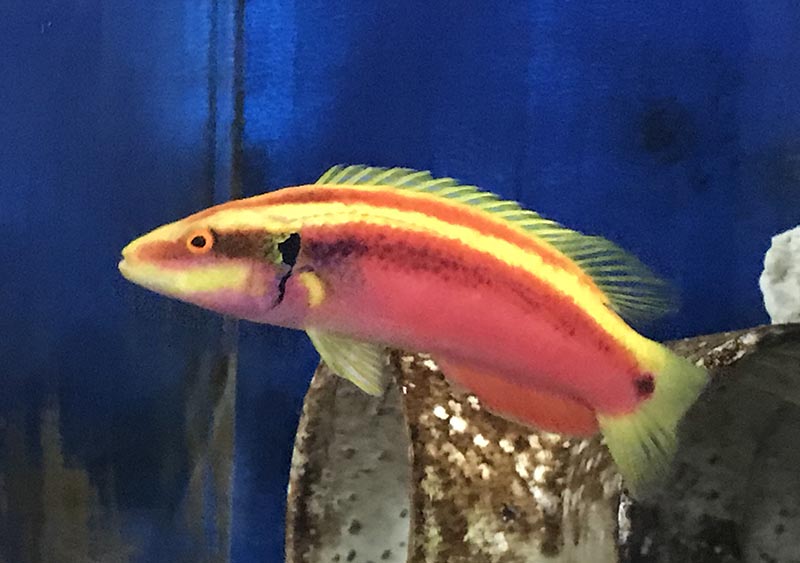
All breeding projects must start with broodstock; here, the rare deepwater Neon or Sunrise Hogfish (Bodianus sanguineus). Image credit: Karen Brittain
Karen Brittain continues to quietly break new ground in her Hawaii-based fishroom; the aquarium world will be graced by a captive-bred handful of the rarely-encountered and very expensive deepwater Sunrise Hogfish (Bodianus sanguineus). Brittain reports that her broodstock pair was collected by the dive team at Hawaiian Reefer and was spawning within two months. This species has now been successfully reared twice under her meticulous care.
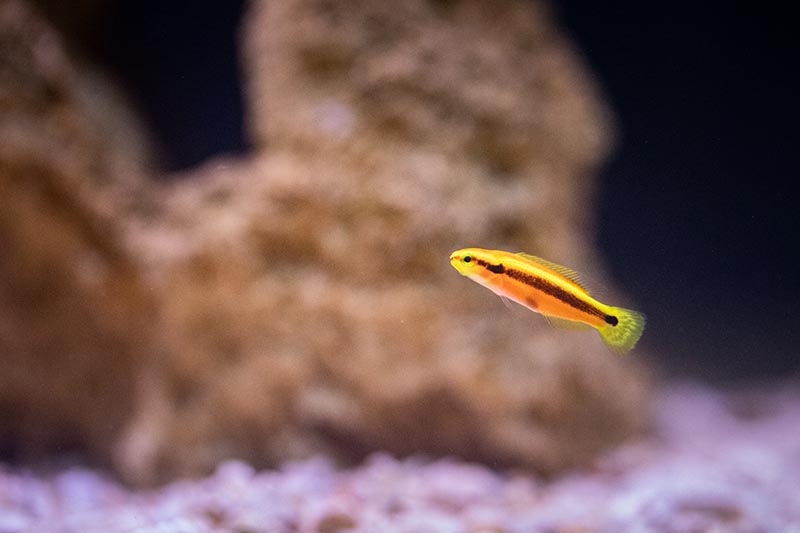
Karen Brittain has now successfully spawned and reared multiple Sunrise Hogfish in her lab. Image credit: Leighton Lum.
Brittain notes that the species has an exceptionally long larval duration, well over 100 days; at 114 days, she notes that both juveniles and pre-settlement offspring are still present in her current batch. The juveniles are said to be extremely hardy, active, and intelligent—they rapidly learned who was feeding them!
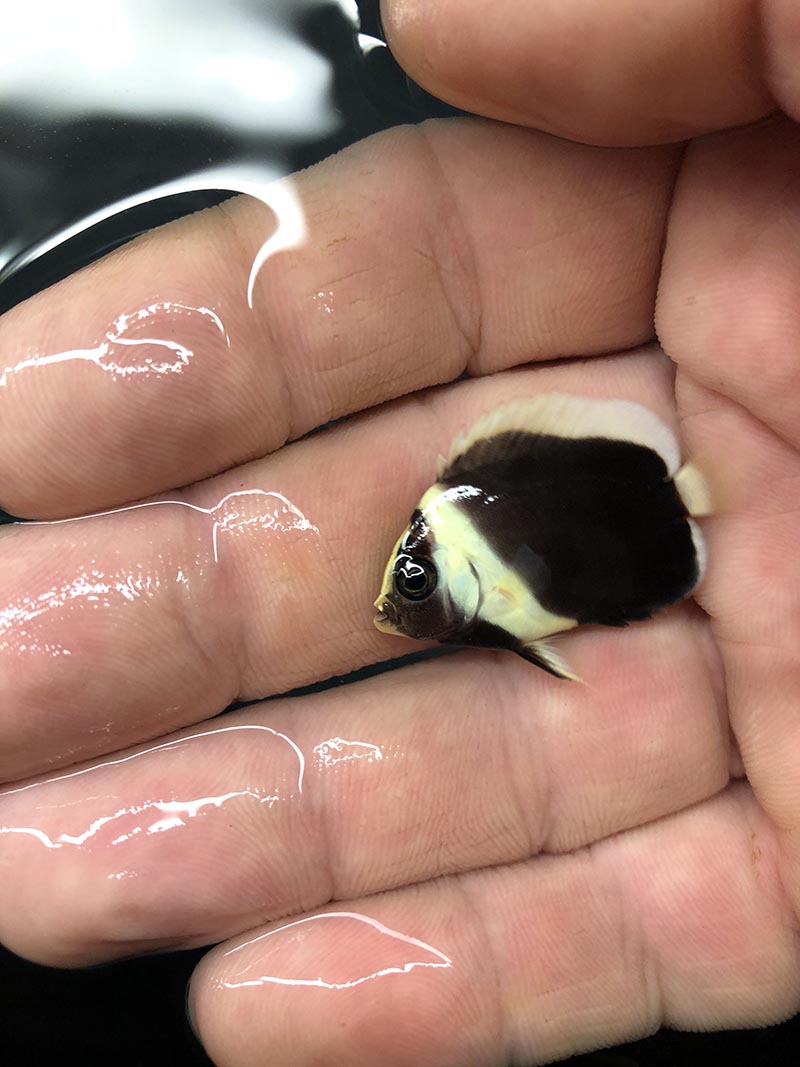
It’s so new it hasn’t even been described, but Poma Labs has already successfully bred Chaetodontoplus sp. “Black Phantom.” Image credit: Dr. Matthew L. Wittenrich/Poma Labs
Dr. Matthew L. Wittenrich’s Poma Labs in Vero Beach, Florida, another boutique breeder of high-end marine fishes, introduced a captive-bred option for the as-yet-undescribed Black Phantom Angelfish (Chaetodontoplus sp.). Poma Labs also produced the man-made hybrid of the Blue Line and Conspicuous Angelfish, Chaetodontoplus (septentrionalis X conspicillatus). Within the offspring of this mating, the world’s first-ever longfin saltwater angelfish was discovered.
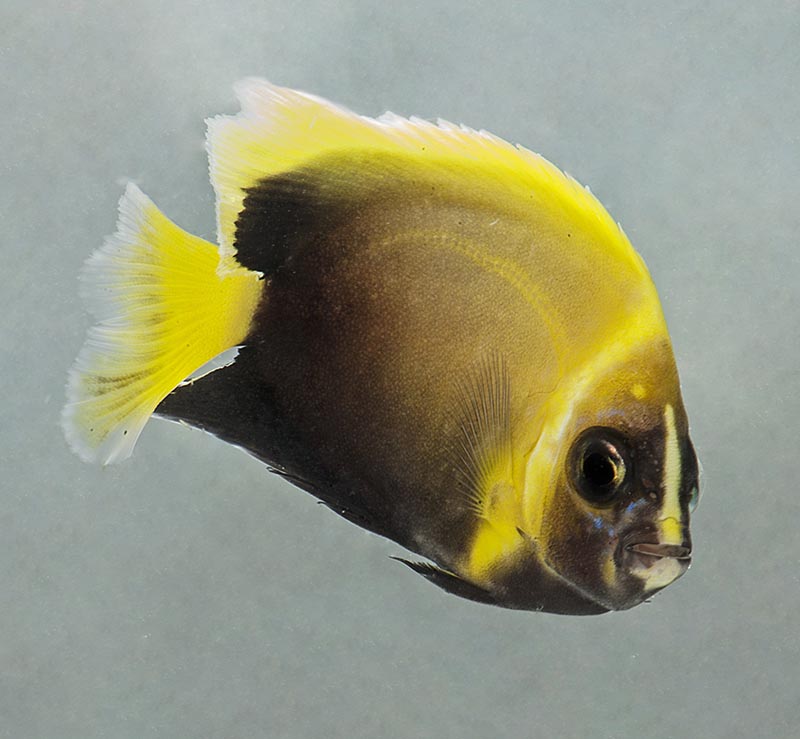
Singular in every regard, this long-finned hybrid of Chaetodontoplus (septentrionalis X conspiculatus) was discovered in Poma Labs breeding. Image credit: Dr. Matthew L. Wittenrich/Poma Labs
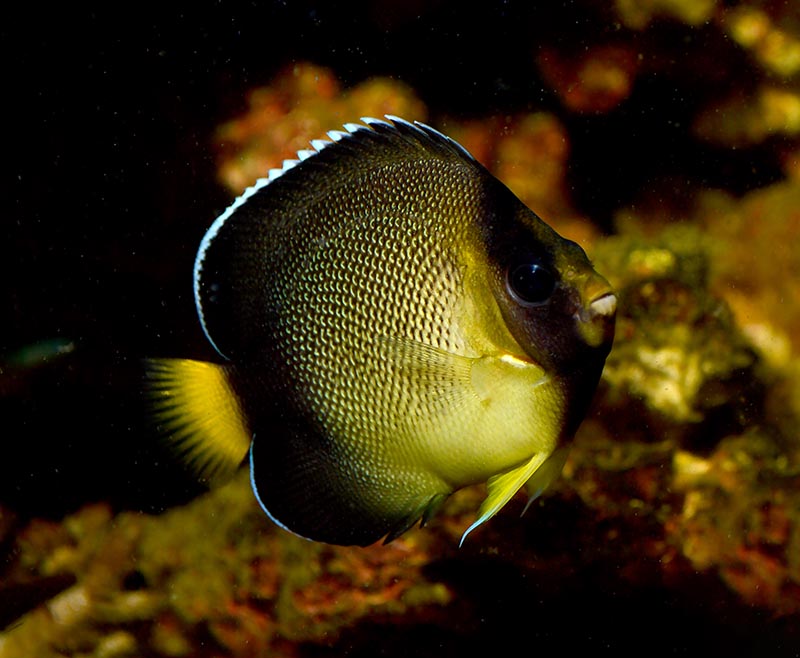
A well-grown captive-bred Cream Angelfish (Apolemichthys xanthurus) produced by
Sustainable Aquatics. Image credit: Matt Pedersen
In another angelfish milestone, Tennessee-based Sustainable Aquatics tackled the production of three species of angelfish in 2018, one of which resulted in a species first with a captive-bred Cream Angelfish (Apolemichthys xanthurus).
Marine Monos
At the urging of Jonathan Foster, we’ve decided to include monos on our species list. While the aquarium trade often considers them to be freshwater or brackish-water aquarium species, the reality is that adults are pelagic-spawning marine fish, and the larvae can only be reared in saltwater. While juveniles can inhabit environments of reduced salinity, they do not require it; the reality is that Monos are ornamental marine fish, and they provide an active, flashy, silvery display when kept in shoals. University of Florida’s Tropical Aquaculture Lab was responsible for the first captive production of the Sebae Mono (Monodactylus sebae) in 2007. Foster was part of that research and in 2015, his company FishEye Aquaculture (Florida) successfully commercialized the species for the aquarium trade. It’s unclear who first pioneered the breeding of the more widespread Silver Mono (Monodactylus argenteus), but FishEye routinely produces this species as well.
For the Experts
Foster has leveraged his existing skill set with breeding grunts to claim a species first this year with the beautiful and mostly monochromatic Cottonwick Grunt (Haemulon melanurum), a fish destined to be snapped up by public aquariums looking to source captive-bred species for use in creating large schools in big display tanks.
Keeping with the theme of marine ornamentals that might be more welcomed by the public aquarium world, scientists at Roger Williams University (Rhode Island) and the New England Aquarium (Massachusetts) also cracked the code on an entirely new family of fish, producing the nocturnal, aggregation-forming Glassy Sweeper (Pempheris schomburgkii) in their labs. New England Aquarium aquarists also produced the world’s first captive-bred Black Brotula (Stygnobrotula latebricola) and Brown Chromis (Chromis multilineata) at their Quincy Animal Care Facility.
Researchers Dr. Cortney Ohs, Benjamin Lovewell, Paul Schlict, and Fred Shopnitz, working at University of Florida’s Indian River Research and Education Center with Rising Tide Conservation, added a beautiful and functional butterflyfish to the list: the Banded Butterflyfish (Chaetodon striatus), which happens to be a fairly good destroyer of Aiptasia in a reef aquarium, and which will leave your coveted SPS alone (a classic “reef-safe with caution” warning applies here!).
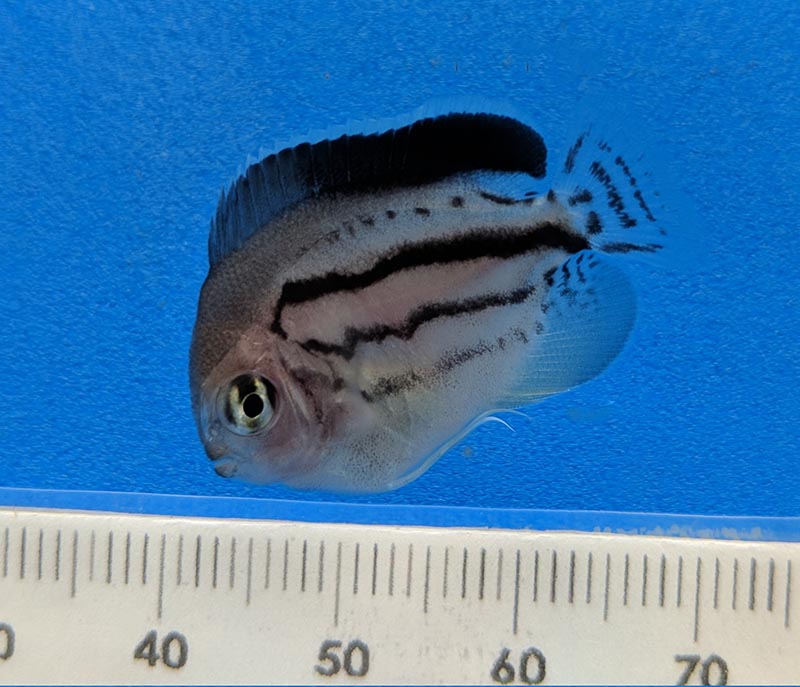
Lamarck’s Angelfish, Genicanthus lamarck, is finally added to the captive-bred species list. Image credit: Tim Morrissey & Andrew Hinrich/Omaha’s Henry Doorly Zoo and Aquarium
We’re not sure how we overlooked the breeding of Lamarck’s Angelfish (Genicanthus lamarck); Noel Heinsohn, now the Hatchery Manager for Fundación Grupo Puntacana (Dominican Republic), successfully reared this species in 2017 while serving as the Aquaculture Aquarist at the Long Island Aquarium (New York). The captive breeding of the Lamarck’s Angelfish was repeated just months later by Tim Morrissey, Andrew Hinrichs, and colleagues at Omaha’s Henry Doorly Zoo and Aquarium (Nebraska) in 2017, and then again in 2018.
It may seem that little headway has been made by amateur breeders; professional breeders, large-scale operations, and research programs are responsible for nearly all the additions to the list this year. But that’s not to say there isn’t room out there for the home hobbyist or casual breeder to claim a species first of their own. Just as August started, German aquarist Herbert Nigl, proprietor of the wholesale operation Aquarium Dietzenbach, shared definitive success breeding the Hi-Fin Red Banded Goby (Stonogobiops nematodes). We are excited to share the success of students and faculty at Southampton High School on Long Island, New York, who tackled the challenge of breeding the rarely encountered Lagoon Shrimp Goby (Cryptocentrus cyanotaenia), a story we plan on sharing in more detail in the near future.
In summary:
Bali Aquarich
- Blacktail Angelfish (Centropyge eibli)
- Personifer Angelfish (Chaetodontoplus personifer)
- Rock Beauty Angelfish (Holacanthus tricolor)
- Cortez Angelfish (Pomacanthus zonipectus)
- Regal Angelfish (Pygoplites diacanthus)
- Purple Tang (Zebrasoma xanthurum)
ORA (Oceans Reefs and Aquariums)
- Springer’s Damsel (Chrysiptera springeri)
- Black Comb-tooth Blenny (Ecsenius namiyei)
- Allen’s Damselfish (Pomacentrus alleni)
- Lemon Damselfish (Pomacentrus moluccensis
- Two-Barred Rabbitfish (Siganus virgatus)
Biota Marine Life Nursery
- Starry Goby (Asterropteryx semipunctata)
- Swallowtail Angelfish (Genicanthus melanospilos)
- Squarespot Anthias (Pseudanthias pleurotaenia)
- Ring-eye Pygmy Goby (Trimma benjamini)
- Red-lined Pygmy Goby (Trimma striatum)
Pei-Sheng Chiu and colleagues
- Elongate Surgeonfish (Acanthurus mata)
- Ornate Goby (Istigobius ornatus)
- Mangrove Goby (Mugilogobius cavifrons)
- Bignose Unicornfish or Valmingi Tang (Naso vlamingii)
New England Aquarium
- Brown Chromis (Chromis multilineata)
- Black Brotula (Stygnobrotula latebricola)
New England Aquarium & Roger Williams University
- Glassy Sweeper (Pempheris schomburgkii)
Sustainable Aquatics:
- Cream Angelfish (Apolemichthys xanthurus)
FishEye Aquaculture:
- Cottonwick Grunt (Haemulon melanurum)
Poma Labs:
- Black Phantom Angelfish (Chaetodontoplus sp. ‘Blank Phantom’)
Herbert Nigl
- Hi-fin Red Banded Goby (Stonogobiops nematodes)
Karen Brittain
- Sunrise Hogfish (Bodianus sanguineus)
University of Florida/Rising Tide Conservation
- Banded Butterflyfish (Chaetodon striatus)
Long Island Aquarium
- Lamark’s Angelfish (Genicanthus lamark)
Southampton High School
- Lagoon Shrimpgoby (Cryptocentrus cyanotaenia)
Unattributed, overlooked, or historical accomplishments:
- Mono Sebae (Monodactylus sebae)
- Silver Mono (Monodactylus argenteus)
- Half-Spine Seahorse (Hippocampus semispinosus)
- Estuarine Frillfin (Bathygobius andrei)
- Live Sharksucker (Echeneis naucrates)
- Speckled Carpet Shark (Hemiscyllium trispeculare)
- Longfin Batfish (Platax teira)
- Short-tail Nurse Shark (Pseudoginglymostoma brevicaudatum)
The new 2019 Captive Bred Marine Fish Species List now supersedes the 2018 list, the 2017 list, the 2016 list, the 2015 list, the 2014 list, and the 2013 list. Color-coded perceived availability in the United States from February 2018 through early August 2019 has been included this year:
Orange Common Name = New to the list this year
Pink Common Name = New to the list this year, but as a formerly overlooked accomplishment
Green = Commonly Available. Easy to find as a captive-bred fish, often from more than one source, throughout 2018 and the first half of 2019.
Blue – Moderate to Low. Might have taken some searching, and availability may have been limited, potentially only with one source, but was reasonably obtainable as a captive-bred fish in 2018/2019.
Purple = Scarce. Generally only one source or breeder is known, and potentially only a handful of specimens may have been available. You may have “had to know someone” or even know the breeder directly in order to obtain them as captive-bred fish during 2018/2019.
Black = None. The authors and consulted parties were unaware of any retail availability of this species from a captive-bred source during 2018/2019.
Angelfishes (Pomacanthidae)
Apolemichthys arcuatus, Bandit Angelfish
Apolemichthys trimaculatus, Flagfin Angelfish
Apolemichthys xanthopunctatus, Goldflake Angelfish
Apolemichthys xanthurus, Cream Angelfish
Centropyge acanthops, African Pygmy Angelfish
Centropyge argi, Cherub Angelfish
Centropyge bicolor, Bicolor Angelfish
Centropyge bispinosa, Coral Beauty Angelfish
Centropyge colini, Collins or Cocos Keeling Angelfish
Centropyge debelius, Debelius Angelfish
Centropyge eibli, Blacktail Angelfish
Centropyge fisheri, Fisher’s Angelfish
Centropyge flavissima, Lemonpeel Angelfish
Centropyge interruptus, Japanese Pygmy Angel
Centropyge joculator, Joculator Angelfish
Centropyge loricula, Flame Angelfish
Centropyge multicolor, Multicolor Angelfish
Centropyge potteri, Potter’s Angelfish
Centropyge resplendens, Resplendent Angelfish
Chaetodontoplus caeruleopunctatus, Bluespotted Angelfish
Chaetodontoplus cephalareticulatus, Maze Angelfish
Chaetodontoplus conspicillatus, Conspicuous Angelfish
Chaetodonotplus duboulayi, Scribbled Angelfish
Chaetodonotplus melasoma, Grey Poma or Black Velvet Angelfish
Chaetodonotplus meridethi, False Personifer Angelfish
Chaetodontoplus mesoleucus, Singapore Angelfish
Chaetodontoplus personifer, Personifer Angelfish
Chaetodontoplus septentrionalis, Bluestriped Angelfish
Chaetodontoplus sp., Black Phantom Angelfish
Genicanthus bellus, Ornate Angelfish
Genicanthus lamark, Lamark’s Angelfish
Genicanthus melanospilos, Swallowtail Angelfish
Genicanthus personatus, Masked Angelfish
Genicanthus watenabei, Blackedged Angelfish
Holacanthus clarionensis, Clarion Angelfish
Holacanthus passer, Passer or King Angelfish
Holacanthus tricolor, Rock Beauty Angelfish
Paracentropyge multifasciata, Multibar Angelfish
Paracentropyge venusta, Purplemask Angelfish
Pomacanthus annularis, Annularis Angelfish
Pomacanthus arcuatus, Gray Angelfish
Pomacanthus asfur, Asfur Angelfish
Pomacanthus maculosus, Yellowbar Angelfish
Pomacanthus navarchus, Majestic or Blue Girdled Angelfish
Pomacanthus paru, French Angelfish
Pomacanthus semicirculatus, Semicircle Angelfish
Pomacanthus sexstriatus, Sixbar Angelfish
Pomacanthus zonipectus, Cortez Angelfish
Pygoplites diacanthus, Regal Angelfish
Anthias (Serranidae)
Odotanthias borbonius, Borbonius Anthias
Odontanthias fuscipinnis, Hawaiian Yellow Anthias
Pseudanthias hypselosoma, Stocky Anthias
Pseudanthias pleurotaenia, Squarespot Anthias
Pseudanthias squamipinnis, Lyretail Anthias
Assessors (Plesiopidae)
Assessor flavissimus, Yellow Assessor
Assessor macneilli, Blue Assessor
Assessor randalli, Randal’s Assessor
Basslets (Serranidae)
Liopropoma carmabi, Candy Basslet
Liopropoma rubre, Swissguard Basslet
Rainfordia opercularis, Flathead Perch
Batfishes (Ephippidae)
Chaetodipterus faber, Atlantic Spadefish
Platax bativianus, Zebra Batfish
Platax orbicularis, Orbiculate Batfish
Platax pinnatus, Pinnatus Batfish
Platax teira, Longfin Batfish
Blennies (Blenniidae)
Chasmodes bosquianus, Striped Blenny
Ecsenius gravieri, Red Sea Mimic Blenny
Ecsenius bicolor, Bicolor Blenny
Ecsenius namiyei, Black Comb-tooth Blenny
Enchelyurus flavipes, Goldentail Comb-Tooth Blenny
Hypleurochilus multifilis, Featherduster Blenny
Hypsoblennius hentz, Feather Blenny
Meiacanthus atrodorsalis, Forktail Blenny
Meiacanthus bundoon, Bundoon Blenny
Meiacanthus grammistes, Striped Fang Blenny
Meicanthus kamohari, Kamohara Blenny
Meiacanthus mossambicus, Mozambique Fang Blenny
Meiacanthus nigrolineatus, Blackline Fang Blenny
Meiacanthus oualanensis, Canary Fang Blenny
Meiacanthus smithi, Disco Blenny
Meiacanthus tongaensis, Fang Blenny (Tonga)
Parablennius marmoreus, Seaweed Blenny
Petroscirtes breviceps, Mimic Fang Blenny
Salaria pavo, Peacock Blenny
Scartella cristata, Molly Miller Blenny
Boxfishes (Ostraciidae)
Acanthostracion quadricornis, Scrawled Cowfish
Brotulas, viviparous (Bythitidae)
Stygnobrotula latebricola, Black Brotula
Butterflyfishes (Chaetodontidae)
Chaetodon klienii, Klien’s, Orange or Sunburst Butterflyfish
Chaetodon milliaris, Milletseed or Lemon Butterflyfish
Chaetodon sedentarius, Reef Butterflyfish
Chaetodon striatus, Banded Butterflyfish
Forcipiger flavissimus, Longnose Butterflyfish (note, was erroneously listed as F. longirostris on the 2018 list)
Parachaetodon ocellatus, Kite Butterflyfish
Cardinalfishes (Apogonidae)
Apogon notatus, Spotnape Cardinalfish
Apogonichthyoides melas, Black Cardinalfish
Apogonichthyoides nigripinnis, Bullseye Cardinalfish
Cheilodipterus quinquelineatus, Five-Lined Cardinalfish
Fowleria flammea, Red Stop Light Cardinalfish
Nectamia bandanensis, Bigeye Cardinalfish
Ostorhinchus compressus, Ochre-Striped Cardinalfish
Ostorhinchus cyanosoma, Yellow-Striped Cardinalfish
Ostorhinchus luteus, Yellow Cardinalfish
Ostorhinchus margaritophorus, Copper Lined Cardinalfish
Ostorhinchus quadrifasciatus, Two-Striped Cardinalfish
Pterapogon kauderni, Banggai Cardinalfish
Pterapogon mirifica, Sailfin Cardinalfish
Sphaeramia nematoptera, Pajama Cardinalfish
Sphaeramia orbicularis, Orbic Cardinalfish
Zoramia leptacantha, Threadfin Cardinalfish
Marine Catfishes (Plotosidae)
Plotosus lineatus, Striped Eel Catfish
Clingfishes (Gobiesocidae)
Gobiesox punctulatus, Stippled Clingfish
Gobiesox strumosus, Skilletfish
Clownfishes (Pomacentridae)
Amphiprion akallopisos, Skunk Clownfish
Amphiprion akindynos, Barrier Reef Clownfish
Amphiprion allardi, Allard’s Clownfish
Amphiprion barberi, Fiji Barberi Clownfish
Amphiprion bicinctus, Red Sea (Two-Barred) Clownfish
Amphiprion chrysogaster, Mauritian Clownfish
Amphiprion chrysopterus, Orangefin/Bluestripe Anemonefish
Amphiprion clarkii, Clarkii Clownfish
Amphiprion ephippium, Red Saddleback Clownfish
Amphiprion frenatus, Tomato Clownfish
Amphiprion latezonatus, Wide Band Clownfish
Amphiprion latifasciatus, Madagascar Clownfish
Amphiprion leucokranos, Whitebonnet Clownfish
Amphiprion mccullochi, McCulloch’s Clownfish
Amphiprion melanopus, Cinnamon Clownfish
Amphiprion nigripes, Blackfinned Clownfish
Amphiprion ocellaris, Ocellaris Clownfish
Amphiprion percula, Percula Clownfish
Amphiprion perideraion, Pink Skunk Clownfish
Amphiprion polymnus, Saddleback Clownfish
Amphiprion rubrocinctus, Australian Clownfish
Amphiprion sandaracinos, Orange Skunk Clownfish
Amphiprion sebae, Sebae Clownfish
Amphiprion tricinctus, Three-Band Clownfish
Premnas biaculeatus, Maroon Clownfish
Convict Blennies (Pholidichthyidae)
Pholidichthys leucotaenia, Convict Blenny, Engineer Goby
Damselfishes (Pomacentridae)
Abudefduf saxatilis, Sergeant Major
Acanthochromis polyacanthus, Orange Line Chromis
Amblyglyphidodon aureus, Golden Damselfish
Amphyglyphidodon curacao, Staghorn Damselfish
Amblyglyphidodon leucogaster, Yellow-belly Damselfish
Amblyglyphidodon ternatensis, Ternate Damselfish
Chromis cyaneus, Caribbean Blue Reef Chromis
Chromis multilineata, Brown Chromis
Chromis nitida, Barrier Reef Chromis
Chromis viridis, Blue Green Chromis
Chrysiptera cyanea, Blue Devil Damselfish
Chrysiptera hemicyanea, Azure Damselfish
Chrysiptera parasema, Yellowtail Damselfish
Chrysiptera rex, King Demoiselle
Chrysiptera rolandi, Roland’s Damselfish
Chrysiptera springeri, Springer’s Damsel
Chrysiptera talboti, Talbot’s Damselfish
Chrysiptera taupou, Fiji Blue Devil
Dascyllus albisella, Whitespot Damselfish, Hawaiian Dascyllus
Dascyllus aruanus, Three Stripe Damselfish
Dascyllus trimaculatus, Three Spot Domino Damselfish
Hypsypops rubicundus, Garibaldi Damselfish
Microspathodon chrysurus, Jewel Damselfish
Neoglyphidodon crossi, Cross’s Damselfish
Neoglyphidodon melas, Bowtie Damselfish
Neoglyphidodon nigroris, Black and Gold Chromis
Neopomacentrus bankieri, Lyretail Damselfish
Neopomacentrus cyanomos, Regal Damselfish
Neopomacentrus filamentosus, Brown Damselfish
Neopomacentrus nemurus, Yellow-Tipped Damselfish
Neopomacentrus violascens, Violet Demoiselle
Pomacentrus alleni, Allen’s Damselfish
Pomacentrus amboinensis, Ambon Damselfish
Pomacentrus caeruleus, Caerulean Damselfish
Pomacentrus coelestis, Neon Damselfish
Pomacentrus nagasakiensis, Nagasaki Damselfish
Pomacentrus moluccensis, Lemon Damselfish
Pomacentrus pavo, Sapphire Damselfish
Dartfishes (Ptereleotridae)
Nemateleotris decora, Purple Firefish
Parioglossus cf. dotui, Dotui Dartfish
Dottybacks (Pseudochromidae)
Congrogadus subducens, Wolf Blenny
Cypho purpurascens, Oblique Lined Dottyback
Labracinus cyclophthalmus, Red Dottyback
Labracinus lineatus, Lined Dottyback
Manonichthys alleni, Allen’s Dottyback
Manonichthys polynemus, Longfin Dottyback
Manonichthys splendens, Splendid Dottyback
Ogilbyina novaehollandiae, Australian Pseudochromis
Oxycercichthys veliferus, Sailfin Dottyback
Pictichromis diadema, Diadem Dottyback
Pictichromis paccagnellae, Bicolor or Royal Dottyback
Pictichromis porphyrea, Magenta Dottyback
Pseudochromis aldabraensis, Neon Dottyback
Pseudochromis bitaeniatus, Double Striped Dottyback
Pseudochromis coccinicauda, Yellow-Breasted Dottyback
Pseudochromis cyanotaenia, Blue Bar Dottyback
Pseudochromis dilectus, Dilectus Dottyback
Pseudochromis elongatus, Red Head Elegant Dottyback
Pseudochromis flavivertex, Sunrise Dottyback
Pseudochromis fridmani, Orchid Dottyback
Pseudochromis fuscus, Dusky or Yellow Dottyback
Pseudochromis olivaceus, Olive Dottyback
Pseudochromis sankeyi, Sankey’s or Striped Dottyback
Pseudochromis springeri, Springer’s Dottyback
Pseudochromis steenei, Flamehead or Steen’s Dottyback
Pseudochromis tapeinosoma, Blackmargin Dottyback
Pseudochromis tonozukai, Tono’s or Orange Peel Dottyback
Pseudoplesiops wassi, Fleck Fin Dottyback
Dragonets (Callionymidae)
Callionymus bairdi, Lancer Dragonet
Callionymus enneactis, Mosaic Dragonet
Synchiropus ocellatus, Scooter Blenny
Synchiropus picturatus, Spotted Mandarin
Synchiropus splendidus, Green Mandarin
Synchiropus stellatus, Red Scooter Blenny
Synchiropus sycorax, Ruby Red Dragonet
Drums (Sciaenidae)
Equetus lanceolatus, Jackknife Fish
Equetus punctatus, Spotted Drum
Pareques acuminatus, High Hat
Pareques umbrosus, Cubbyu
Filefishes (Monacanthidae)
Acreichthys tomentosus, Bristletail Filefish
Acreichthys radiata, Radiated Filefish
Oxymonacanthus longirostris, Orange Spotted Filefish
Rudarius ercodes, Whitespotted Pygmy Filefish
Stephanolepis hispidus, Planehead Filefish
Flagtails (Kuhliidae)
Kuhlia mugil, Barred Flagtail
Frogfishes (Antennariidae)
Rhycherus filamentosus, Tasseled Frogfish
Gobies (Gobiidae)
Amblygobius esakiae, Snoutspot Goby
Amblygobius calvatus, Speartail Goby
Amblygobius linki, Link’s Goby
Amblygobius phalaena, Banded Sleeper Goby
Asterropteryx semipunctata, Starry Goby
Bathygobius andrei, Estuarine Frillfin
Coryphopterus personatus, Masked Goby
Cryptocentroides gobiodes, Crested Oyster Goby
Cryptocentrus cinctus, Yellow Watchman Goby
Cryptocentrus cyanotaenia, Lagoon Shrimpgoby
Cryptocentrus fasciatus, Y-Bar Watchman Goby
Cryptocentrus leptocephalus, Pink-Speckled Shrimp Goby
Cryptocentrus lutheri, Luther’s Prawn-Goby
Elacatinus chancei, Shortstripe Goby
Elacatinus colini, Belize Spongegoby
Elacatinus evelynae, Golden Neon or Sharknose Goby
Elacatinus figaro, Barber Goby
Elacatinus genie, Cleaning Goby
Elacatinus horsti, Yellowline Goby
Elacatinus louisae, Spotlight Goby
Elacatinus lori, Linesnout Goby
Elacatinus oceanops, Neon Goby
Elacatinus prochilos, Broadstripe Goby
Elacatinus puncticulatus, Red Headed Goby
Elacatinus randalli, Yellownose Goby
Elacatinus xanthiprora, Golden Goby
Eviota atriventris, Blackbelly Dwarfgoby
Eviota bifasciata, Twostripe Eviota
Eviota nigriventris, Red Neon Eviota Goby
Eviota punctulata, Finespot Eviota
Fusigobius pallidus, Transparent Cave Goby or Pale Sandgoby
Gobiodon citrinus, Citron Clown Goby
Gobiodon okinawae, Okinawan Goby
Gobiopsis quinquecincta, Jaguar Goby
Gobiosoma bosc, Naked Goby
Istigobius ornatus, Ornate Goby
Koumansetta hectori, Hector’s Goby
Koumansetta rainfordi, Rainford’s Goby
Lythrypnus dalli, Catalina Goby
Mugilogobius cavifrons, Mangrove Goby
Priolepis cincta, Girdled Goby
Signigobius biocellatus, Signal Goby
Stonogobiops nematodes, Black Ray, Yellow Rose, or Hi-fin Red Banded Goby
Stonogobiops yasha, Yasha or White Ray Goby
Tigrigobius macrodon, Tiger Goby
Tigrigobius multifasciatus, Green Banded Goby
Trimma benjamini, Ring-eye Pygmy Goby
Trimma caesiura, Grooved Dwarfgoby
Trimma striatum, Red-lined Pygmy Goby
Grammas (Grammatidae)
Gramma dejongi, Cuban Basslet
Gramma loreto, Royal Gramma
Gramma melacara, Blackcap Basslet
Lipogramma klayi, Bicolor Basslet
Groupers (Serranidae)
Chromileptes altivelis, Panther or Humpback Grouper
Epinephelus lanceolatus, Giant or Bumblebee Grouper
Epinephelus marginatus, Dusky Grouper
Plectropomus areolatus, Squaretail Grouper
Pectropomus leopardus, Coral Trout
Serranus subligarius, Belted Sandfish
Grunts (Haemulidae)
Anisotremus virginicus, Porkfish
Haemulon chrysargyreum, Smallmouth Grunt
Haemulon flavolineatum, French Grunt
Haemulon melanurum, Cottonwick Grunt
Plectorhinchus vittatus, Indian Ocean Oriental Sweetlips
Hamlets (Serranidae)
Hypoplectrus gemma, Blue Hamlet
Hypoplectrus guttavarius, Shy Hamlet
Hypoplectrus unicolor, Butter Hamlet
Jacks (Carangidae)
Coryphaena hippurus, Mahi Mahi
Gnathanodon speciosus, Golden Trevally, Pilot Fish
Selene vomer, Lookdown
Trachinotus carolinus, Pompano
Trachinotus goodie, Palometa
Jawfishes (Opistognathidae)
Opistognathus aurifrons, Pearly Jawfish
Opistognathus macrognathus, Banded Jawfish
Opistognathus punctatus, Finespotted Jawfish
Labrasomid Blennies (Labrisomidae)
Paraclinus grandicomis, Horned Blenny
Moonyfishes (Monodactylidae)
Monodactylus argenteus, Silver Mono
Monodactylus sebae, Mono Sebae
Pipefishes (Syngnathidae)
Doryrhamphus excisus, Bluestripe Pipefish
Doryrhamphus janssi, Janss’s Pipefish
Dunckerocampus baldwini, Flame Pipefish, Red Striped Pipefish
Dunckerocampus chapmani, Glow-tail Pipefish
Dunckerocampus dactyliophorus, Ringed Pipefish
Dunckerocampus naia, Naia Pipefish
Dunckerocampus pessuliferus, Yellow Banded Pipefish
Haliichthys taeniophorus, Ribboned Pipefish
Syngnathoides biaculeatus, Alligator pipefish
Syngnathus acus, Greater pipefish
Syngnathus floridae, Dusky Pipefish
Syngnathus fuscus, Northern Pipefish
Syngnathus leptorhynchus, Bay Pipefish
Syngnathus scovelli, Gulf Pipefish
Syngnathus typhle, Broadnosed Pipefish
Porcupinefishes (Diodontidae)
Diodon holocanthus, Longspined Porcupinefish
Puffers (Tetraodontidae)
Arthoron nigropunctatus, Dog-faced Pufferfish
Chilomycterus schoepfi, Striped Burrfish
Canthigaster rostrata, Sharpnose Puffer
Lagocephalus spadiceus, Half-Smooth Golden Puffer
Sphoeroides annulatus, Bullseye Pufferfish
Sphoeroides maculatus, Northern Puffer
Rabbitfishes (Siganidae)
Siganus canaliculatus, White-Spotted Spinefoot
Siganus fuscescens, Mottled Spinefoot
Siganus guttatus, Oranged-Spotted Rabbitfish
Siganus lineatus, Golden-Lined Spinefoot
Siganus rivulatus, Marbled Spinefoot
Siganus vermiculatus, Vermiculated Rabbitfish
Siganus virgatus, Two-Barred Rabbitfish
Remoras (Echeneidae)
Echeneis naucrates, Live Sharksucker
Roundheads & Bettas (Plesiopidae)
Calloplesiops altivelis, Marine Betta, Comet
Plesiops corallicola, Bluegill Longfin
Trachinops taeniatus, Eastern Hulafish
Seadragons (Syngnathidae)
Solegnathus spinosissimus, Spiny Seadragon
Phyllopteryx taeniolatus, Common or Weedy Seadragon
Seahorses (Syngnathidae)
Hippocampus abdominalis, Bigbelly Seahorse
Hippocampus algiricus, West African Seahorse
Hippocampus angustus, Western Spiny Seahorse
Hippocampus barbouri, Barbour’s Seahorse
Hippocampus bargibanti, Bargibant’s Seahorse
Hippocampus breviceps, Short-Head Seahorse
Hippocampus capensis, Knysna Seahorse
Hippocampus comes, Tiger Tail Seahorse
Hippocampus coronatus, Crowned Seahorse
Hippocampus erectus, Lined Seahorse
Hippocampus fisheri, Fisher’s Seahorse
Hippocampus fuscus, Sea Pony
Hippocampus guttulatus, Long-Snouted Seahorse
Hippocampus hippocampus, Short-Snouted Seahorse
Hippocampus histrix, Thorny Seahorse
Hippocampus ingens, Pacific Seahorse
Hippocampus kelloggi, Great Seahorse
Hippocampus kuda, Yellow or Common Seahorse (Hippocampus taeniopterus, currently considered a synonym of H. kuda, has also been reared)
Hippocampus patagonicus, Patagonian Seahorse
Hippocampus procerus, High-Crown Seahorse
Hippocampus reidi, Brazilian or Longsnout Seahorse
Hippocampus semispinosus, Half-Spined Seahorse
Hippocampus spinosissimus, Hedgehog Seahorse
Hippocampus subelongatus, Tiger Snout Seahorse
Hippocampus tuberculatus, Knobby Seahorse
Hippocampus trimaculatus, Longnose Seahorse
Hippocampus whitei, White’s Seahorse
Hippocampus zosterae, Dwarf Seahorse
Sharks, Bamboo (Hemiscylliidae)
Chiloscyllium hasseltii, Hasselt’s Bamboo Shark
Chiloscyllium plagiosum, Whitespotted Bamboo Shark
Chiloscyllium punctatum, Brownbanded Bamboo Shark
Hemiscyllium hallistromi, Papuan Epaulette Shark
Hemiscyllium ocellatum, Epaulette Shark
Hemiscyllium trispeculare, Speckled Carpet Shark
Sharks, Bullhead (Heterodontidae)
Heterodontus francisci, Horn Shark
Sharks, Cat (Scyliorhinidae)
Atelomycterus marmoratus, Coral Catshark
Sharks, Nurse (Ginglymostomatidae)
Pseudoginglymostoma brevicaudatum, Short-tail Nurse Shark
Shrimpfishes (Centriscidae)
Aeoliscus strigatus, Razorfish, Shrimpfish
Snappers (Lutjanidae)
Lutjanus sebae, Red Emperor Snapper
Sweepers (Pempheridae)
Pempheris schomburgkii, Glassy Sweeper
Rays, Whiptail (Dasyatidae)
Taeniura lymma, Bluespot Stingray
Tangs & Surgeonfishes (Acanthuridae)
Acanthurus mata, Elongate Surgeonfish
Naso vlamingii, Bignose Unicornfish or Valmingi Tang
Paracanthurus hepatus, Pacific Blue Tang
Zebrasoma flavescens, Yellow Tang
Zebrasoma xanthurum, Purple Tang
Toadfishes (Batrachoididae)
Allenbatrachus grunniens, Grunting Toadfish
Opsanus tau, Oyster Toadfish
Triggerfishes (Balistidae)
Balistes vetula, Queen Triggerfish
Balistoides conspicillum, Clown Triggerfish
Xanthichthys mento, Crosshatch Triggerfish
Triplefins (Tripterygiidae)
Enneapterygius etheostomus, Snake Blenny
Wrasses (Labridae)
Bodianus pulchellus, Cuban Hogfish
Bodianus sanguineus, Sunrise Hogfish
Cheilinus undulates, Humphead Wrasse
Halichoeres melanurus, Melanurus or Hoeven’s Wrasse
Halichoeres ornatissimus, Ornate, Ornamented, or Hawaiian Christmas Wrasse
Labroides dimidiatus, Cleaner Wrasse
Labroides phthirophagus, Hawaiian Cleaner Wrasse
Lachnolaimus maximus, Hogfish
Parajulis poecilepterus, Rainbow Wrasse





Hi,
Thank you for your initiative to produce each year the Captive bred marine fish species list.
I would be interested to get access to the full results of the survey but I didn’t find it as your mentioned here : (…)Representing the responses of more than 30,000 CORAL Magazine and Newsletter subscribers, the full results of the survey are posted online (see References).
Could you please check it and pointed it for me please ?
Best regards
The Raw Data is not available for obvious privacy reasons. However, you can find reporting covering this data in two online locations.
The first is the 2019 MACNA Program Guide – https://www.reef2rainforest.com/2019/08/28/macna-2019-official-program-guide-book/ – this mainly reports some of the more interesting freeform responses we received.
The second is in my 2019 MACNA presentation, in which you’ll find more granular data and many more of the questions that were part of the survey. https://www.reef2rainforest.com/2019/10/24/video-meeting-the-aquaculture-needs-of-your-local-fish-store/
I hope that’s helpful, thanks! – Matt
It is great to see more and more species being captive breed. Sadly very few ever make it to market. And many of the ones that do are put into the same systems at LFS making them very susceptible to the parasites and diseases in these systems. This eliminates one of the big benefits of captive breed fish.one of my favorites, neon gobies have been captive breed for many years vet are still hard to find in stores. When I worked at a fish retailer the companies breeding fish never had enough variety available to justify placing orders with them. While they might be breeding 10 different fish they typically only had a few of 2-3 available in stock at any time. Clown fish being the exception. It’s a catch 22, the breeders can’t justify raising more fish, because the stores can’t justify ordering just a few fish from them. I think LFS handling, availability and distribution are the biggest challenges to getting captive breed fish more main Stream.
Hi,
thank you so much for taking the time and effort to produce this excellent list! It’s fantastic to see that more species are being captive-bred. I am using the list for a research project and wanted to clarify if the listing of a species means that it has been successfully bred even if the availability is none? If you are interested I’d also be happy to share more about the project.